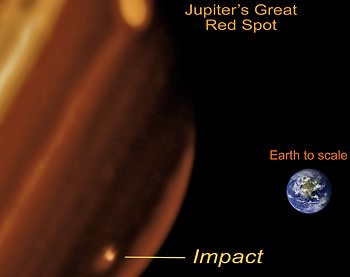By Robert Sanders, UCB Media Relations | 21 July 2009
Complete article here: http://www.berkeley.edu/news/media/releases/2009/07/21_bruise.shtml
 The scar from the probable impact appeared July 19 in Jupiter’s southern hemisphere, and has grown to a size greater than the extent of the Pacific Ocean. This infrared image taken with Keck II on July 20 shows the new feature observed on Jupiter and its relative size compared to Earth. (Paul Kalas ,UCB; Michael Fitzgerald, LLNL/UCLA; Franck Marchis, SETI Institute/UCB; James Graham, UCB)
The scar from the probable impact appeared July 19 in Jupiter’s southern hemisphere, and has grown to a size greater than the extent of the Pacific Ocean. This infrared image taken with Keck II on July 20 shows the new feature observed on Jupiter and its relative size compared to Earth. (Paul Kalas ,UCB; Michael Fitzgerald, LLNL/UCLA; Franck Marchis, SETI Institute/UCB; James Graham, UCB)BERKELEY — Something slammed into Jupiter in the last few days, creating a dark bruise about the size of the Pacific Ocean.
The bruise was noticed by an amateur astronomer on Sunday, July 19. University of California, Berkeley, astronomer Paul Kalas took advantage of previously scheduled observing time on the Keck II telescope in Hawaii to image the blemish in the early morning hours of Monday, July 20. The near infrared image showed a bright spot in Jupiter’s southern hemisphere, where the impact had propelled reflective particles high into the relatively clear stratosphere.
In visible light, the bruise appears dark against the bright surface of Jupiter.
The observation made with the Keck II telescope marks only the second time astronomers have seen the results of an impact on the planet. The first collision occurred exactly 15 years ago, between July 16 and 22, 1994, when more than 20 fragments of comet Shoemaker-Levy 9 collided with Jupiter.
Complete article here: http://www.berkeley.edu/news/media/releases/2009/07/21_bruise.shtml


 NASA Television will provide an HD video feed of the Apollo footage hourly from 12 – 7 p.m. on July 16 and 17. Each feed is one hour. For NASA TV streaming video, downlink and schedule information, visit:
NASA Television will provide an HD video feed of the Apollo footage hourly from 12 – 7 p.m. on July 16 and 17. Each feed is one hour. For NASA TV streaming video, downlink and schedule information, visit:
